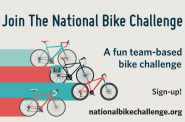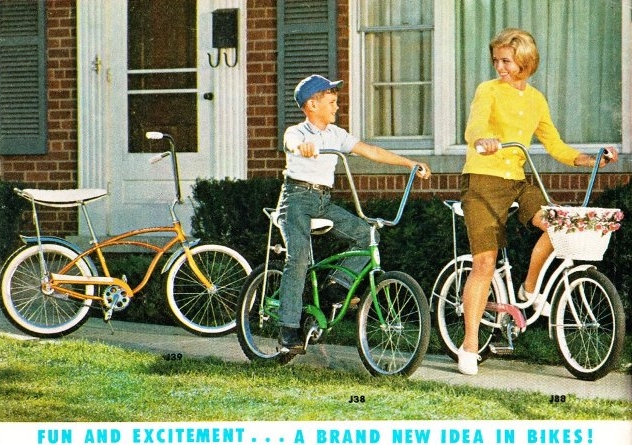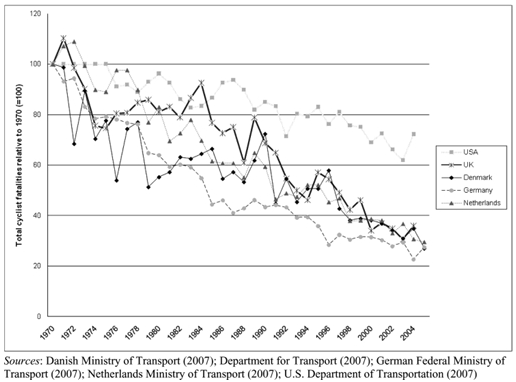Remember When Kids Didn’t Wear Helmets?
Four decades ago 50% of kids bicycled or walked to work. Today its 12%. Is our obsession with safety making kids fat?
When I was a kid, I rode my green 1969 Schwinn Pea Picker with a big sissy bar all over Milwaukee and West Allis with my friends. We never had a safety class other than what our dads taught us, and we didn’t even know there were helmets. We left in the morning and knew we had to be home for lunch or dinner. We all walked or biked to school, to the hobby shop, to the bakery, and to the corner store to get penny candy.Our parents really had no idea where we were or what we were doing.
I know our parents cared about our safety, but people just didn’t worry about things like bicycle crashes back then. We didn’t even wear seat belts in our cars. It was easy to get a job and everyone had great health insurance, so maybe we didn’t worry about much.
Today? I can’t believe the Thudguard Baby Safety Helmet is a real product and not some comedy skit from Saturday Night Live. It’s a sign of the times that parents are so afraid they think kids need helmets in the house.
Back in 1969, about 50 percent of kids walked or biked to school. Fast forward 45 years, and only about 12 percent get to school without a car or bus, even though it is actually a lot safer to ride a bicycle nowadays. We have more trails, bike lanes and even robust safe routes to school programs with great bicycle education, like the program we run.
But it isn’t just biking to school that has almost vanished in one generation. Kids today spend most of their time indoors on the computer, watching television, or playing video games. About the only time kids go outside is for planned, supervised events like soccer practice. A child is six times more likely to play a video game on a typical day than to ride a bike, according to surveys by the Kaiser Family Foundation and the CDC.
I’m really beginning to wonder what “progress” we have made since I was a kid. I’m not advocating to bring back Wham-O Style advertising or saying helmets are the cause of all this. But maybe we should worry less about risk and more about our preoccupation with risk, with our addiction to the myth of convenience and comfort, and to the fact that so much of our daily lives is spent sitting indoors looking at LED screens.
I certainly recognize the hypocrisy of writing this (as I work at my computer 10-12 hours a day) for you to read on your computer. I don’t have the answer, but maybe it will come to me on my ride to the office this morning.
This article was originally published by the Bicycle Federation of Wisconsin.
Bike Czar
-
Join a Bike Ride Under the Polish Moon
 Jun 1st, 2018 by Dave Schlabowske
Jun 1st, 2018 by Dave Schlabowske
-
9 Reasons to Join National Bike Challenge
 May 4th, 2018 by Dave Schlabowske
May 4th, 2018 by Dave Schlabowske
-
Biking Through the Mindoro Cut
 Apr 27th, 2018 by Dave Schlabowske
Apr 27th, 2018 by Dave Schlabowske

























“Four decades ago 50% of kids bicycled or walked to work”
Child labor isn’t legal anymore!
It goes to the question I’v’e been asking for the last few years, “When did we become afraid of everything.”?
I’m not advocating not using safety equipment or being concerned about what our kids are doing and who they are hanging out with, but we are becoming a nation of helicoptering parents.
And don’t give me the “world is a more dangerous place” excuse. The fact is we recognize more of the dangers, we count them and we have a media that feels that it’s doing a public service by running constant scare stories. I give you Ebola and now measles.
I can make a case that we have a small measles outbreak because of the media hype that childhood inoculations caused all kinds of problems and encouraged parents not to get the protection for their kids.
Well written! I had the same questions 10 years ago so we sold our house and all our possessions, packed up our three boys who were then ages 7, 8 and 10, and moved to the jungle for 6 years so they could grow up free. You can read a bit about it here http://www.theoutdoorparent.com/?p=388
While of course I agree with general safety precautions (wearing a seat belt saved my eldest son’s life just a few months ago) the American obsession with our kids and with safety and rules is creating a generation of Americans who can’t solve their way out of a paper bag without someone giving them permission to do so and then providing exact directions, preferably with Dad refereeing and Mom standing by with snacks and a trophy.
The first thing I noticed upon arriving back in the US after being gone our first year was the fear mongering that was everywhere: in the airport, in ads on the radio, in products being marketed each way I turned. When did we become a Nation of Ninnies? We’re afraid of our own shadows. And there’s an app for that. As well as a helmet.
Equally as disturbing as the booming voice of Big Brother telling us what a scary world we live in and therefore, we’d better buy this product or kill that group of people, was the fact that no one else seemed to notice; fear had become an accepted part of the cultural narrative.
I really appreciate the author bringing up this topic. I would be interested to know how others have or are bucking the fear mongering.
It is an evolution in culture. I grew up in the 50s, 60s on the near Southside of Milwaukee. We walked and biked to just about everything. We played outdoors year round. Walking trips to shopping, school, church, library, movies, museum, corner tavern and bowling alley, restaurants, etc. were common practice. The neighborhood playground was staffed with young teens providing guidance and organized games to play. Public pools cost a dime.
Local shopping areas and stores became wiped out by larger out of state chains. It became a drive everywhere society and more dispersed. Home entertainment systems, video games, DVDs, cable, live streaming, computers have made it more efficient for people to hide out in their homes and more detached. We even shop on line.
The growth of fast food choices has grown from a few McDonalds, to vast empires of chains that sell cheap and fast, albeit not very healthy as a steady diet. Eating out somewhere used to be an exception. Now some people drive to get a cup of coffee or latte for $4.
In the last approximate 45 years, we have had a rapid erosion of what was, and what we have today. You can add freeways into the mix since urban centers expanded out to suburbia.
All of this emphasis on “safety” is the result of “liability” created by a huge glut of lawyers. They file lawsuit after lawsuit because they have nothing else to do.
The loss of real jobs in this country has had more impact than we may know.
Years ago, when I was in junior high, my mother would tell us when supper was scheduled. What I did between school and dinner was my business. If something had happened to me, it would have been regarded as a tragedy–but something that just happened, like being struck by lightening. Today it would be regarded as negligent parenting.
When I was an infant in 1951, my mother went to Southgate, then a brand-new shopping center on South 27th St. She took me in my stroller and left the stroller (and me) outside in front of a store while she shopped. Other women did the same with their babies.
It was a different world back then.
There really are two main categories of bike riding aren’t there?
I’m a casual bicyclist, but I’m on my bike 2-3 times a week in all seasons. I don’t wear a helmet, but also don’t ride for speed and distance, and never wear ear buds. I also tend to actually enjoy being alert to my surroundings, saying things out loud like: ‘morning!, ‘scuse me!, on your left!, even sometimes: on your right!
Sidewalk riding was very common back in the day and it’s my anecdotal observation that there aren’t more, but many less, pedestrians than there used to be. I use it regularly as a safety precaution.
Sidewalk riding is sometimes the most logical alternative when considering whether to risk “sharing” the right-of-way on a given stretch of road with a group of horsepower enabled, steel encased citizens.
A funny experience occurred in Bay View while sidewalk riding in the sometimes busy area of South Shore Dr. And Russell Ave.: a quartet of cyclists was standing with their bikes on the sidewalk enjoying a chat as I was riding toward them. As I rode on to the only grass available to me to safely avoid them, they deffered their right-of-way, and all moved in the same direction as I did from the sidewalk to the grass causing me to wobble in confusion and then crash. I don’t recall exactly what I said to them, but we didn’t part in friendship. They were all wearing helmets.
Gary, this may seem counter-intuitive, but it’s been shown time and time again that riding on the sidewalk is much less safe than riding on the road for both you and pedestrians. Your little example of coming across the group of bikers is a small example… but you’re lucky it wasn’t worse… like crossing an intersection where cars are not watching for bikers coming from sidewalks!
I don’t weave on and off sidewalks, and in my experience, entering traffic seated vertically on a tall bike is less dangerous than driving a low profile Geo-Metro at the height of the Ford Explorer population explosion.
These debates about bikes and road safety are not about apples-to-apples issues.
That’s why I’m looking for investors in a new line of defensive bike safety clothing & tools: grit encrusted chaps, indelible ink saddle-bladders, and graffiti tasers (red, blue, green).
Fact: paying a ticket for ‘innattentive driving’ won’t affect most drivers that are inconvenienced by an accident with a bicyclist unless they have to file an insurance claim to repair their paint job.
This article sets up a straw man argument. The main drivers for this change in behavior include crime/personal safety concerns (which may be unrealistic or exaggerated) as well as many kids living much further away from their schools.
It should not be wholly blamed on fear of crashes or laziness.
One major reason parents don’t let kids walk or bike to school is that it is dangerous largely because of all the traffic at the school. Of course “all the traffic at the school” is the cars of the very parents who complain that there is too much traffic.
So the parents who complain about the unsafe, heavy traffic are themselves the cause of the unsafe condition.
My daughter is 12 and I think she should wear a helmet but I never have time to get one I’m kind off worried Ive put this off for three years and ill forget it because she won’t get in a accident, Im not gonna wear one so she doesn’t have to, ( I think she is is fine, besides she 12) but I know that the costs can be high if she falls or gets in an accident, and I know its safer but is it really worth it, your hair gets messed up so bad, I don’t wear one and I consider her older, we live in the city and we bike a lot what is your opinion?
Well said Tom D
Hi Emma, while the point of the argument is that statistically riding a bicycle is safer now than it was when I was a kid, largely due to improved bicycle facilities and helmets, I am not a “helmet Nazi.” At the Bike Fed, we require helmets on our rides and in all the classes we teach. We always let people know the benefits of helmets, but we don’t chastise those who ride without them and we would oppose a mandatory helmet law. Look at the safest places to ride a bicycle in the world (Amsterdam, Copenhagen, etc.) and most people do not wear helmets. That said, I wear one almost every time I ride as do all our staff and I have always asked my daughter to wear a helmet. If wearing a helmet is a deal breaker for someone, I’d rather they got the health benefits from riding a bike than adding another car to our roads and more exhaust to our environment. If the choice is between helmet hair and a skull fracture, I think we would all choose a bad hair day over a trip to the hospital.
Just saw Gary’s comment from 2015 on “ink saddle-bladders” and “graffiti tasers” so car drivers would need to file an insurance claim to get their paint fixed. I’d love to see a bicyclist with those “safety features” pay for that damage when they’re the cause of the accident… (that would never actually happen).
As a cyclist and car driver, I have never been involved in a bike/car accident. However, I’ve witnessed 3 accidents between a car and bike and all three times the biker was at fault. 1. Biker ran a red and hit the side of the car. 2. A biker was on a sidewalk downtown moving rapidly and a car pulled out from a parking garage, unable to see them coming at that speed. 3. Biker riding southbound in a northbound lane and a car turned from eastbound onto northbound lane and biker went over hood of car.
My examples are annecdotal… but I imagine it happens often enough that the biker is at fault that if they’re going to put “offensive weapons” on their bike they better be ready to pay for the damages.
Thanks for sharing your thoughts AG, but you comment about the anecdotal nature of your experience really is key here. Personally, I ride close to 10,000 miles a year and have for the last 25 years or so. I have been involved in 3 crashes in those miles, in all three the driver of the car was ticketed. I of course suffered the real penalty though in terms of pain and suffering. But my experience, like yours, is not really statistically valid. A crash study done by WisDOT found this: “Four out of the top five crash types indicate that the motorist made the critical
error.” That is one important statistic, but I have seen other studies done here and elsewhere that indicated motor vehicles were statistically more likely to be at fault in car/bicycle crashes, but again, the statistics vary quite a bit depending on the study and the location. Here is another overview of crash studies. As far as who pays for damage in a crash, I had to go to court to get the drivers who hit me to pay, there is no law that assigns responsibility to pay in a crash no matter who is at fault.
Four out of five is pretty stark and also not hard to believe. Yes some bike riders are idiots, as AG has experienced, but driving the vehicle is like the second or third or fourth thing most drivers are doing now. They are texting or talking or eating or drinking or reading, and oh yeah they are also driving a vehicle. Distracted driving is totally out of control. Just this morning at Green Bay and Mill in Glendale a woman driving a huge SUV didn’t signal or yield (as she was supposed to do as she was taking a right and had a yield sign) and she nearly hit me. And of course she was on her phone. This is a daily occurrence these days.
Vincent- if you’re riding down GB Rd you’re a brave individual.That choke point underneath the bike trail (old railroad) has almost seen the end of me a few times.
I really don’t like the bike/driver divide in many of these discussions, especially since many people do both. Fact is, there’s people who act unintelligently/obliviously in both cases and a persons number one responsibility is to look out for them. This is why obeying the laws, being alert, and practicing safe habits is important for both drivers and bicyclists. Be safe out there!
That’s true AG, but clearly there’s a wide disparity here. As the WisDOT stats prove, drivers are at fault 80% of the time. That shouldn’t be downplayed.
I have to find that 80% stat a bit suspect… I’ve seen various numbers in the past, and 80% is by far the highest. I’ve also noticed that when the biker is at fault in an accident and the damage is minor, it often goes unreported and thus inflates the numbers for the opposite. If I had more time I’d find some of the info… perhaps later today unless Dave has any info handy?
I’d still imagine it is rather even though, or perhaps a bit more towards drivers at fault. But 80%..?
Is WisDOT not trustworthy? Is there good reason to be skeptical of them? In this era of distracted driving I can’t imagine finding it difficult to believe that stat.
No, but it’s a function of where/how the data is collected. I can certainly believe it in this era of distracted driver, definitely… the reason for skepticism though is that I’ve seen far different numbers in the past.
I agree with both of you AG and Vincent Hanna, and it is always important to remember that pretty much every adult out there riding a bicycle also drives a car. To AG’s point about the statistic, how we parse the data can give us different stats. As I mentioned in that other overview of statistics, the numbers very pretty substantially. To Vincent’s point, we can’t ignore these statistics either, and they do help to counter the commonly held belief that everyone who rides a bike is a scofflaw. Continually raising the point that we all fare better when everyone out there obeys the rules of the road is a message I don’t like to lose sight of. Reminding people (those who ride bikes and also drive cars) about the dangers associated distracted driving and with even small increases in speed when involved in a crash can’t be over emphasized. I also like to end with a reminder that no matter what statistics you look at, cycling has gotten way safer over the last 30 years and if you factor in the health benefits, it is more likely to extend your life than shorten it. Besides, it’s fun!
I found a more recent WisDOT/UW-Milwaukee Crash Study done by Professor Robert Schneider. His review of 229 bicycle/motor vehicle crashes found primary responsibility for the crash to be with the person in the motor vehicle 47% of the time, with the person on the bicycle 38% of the time, with both 7% of the time and unassigned 7% of the time. Those are based on who was given a citation for failing to obey the law, which is not quite the same as assigning “fault” but as close as we get. I got that from page 115 of the study.